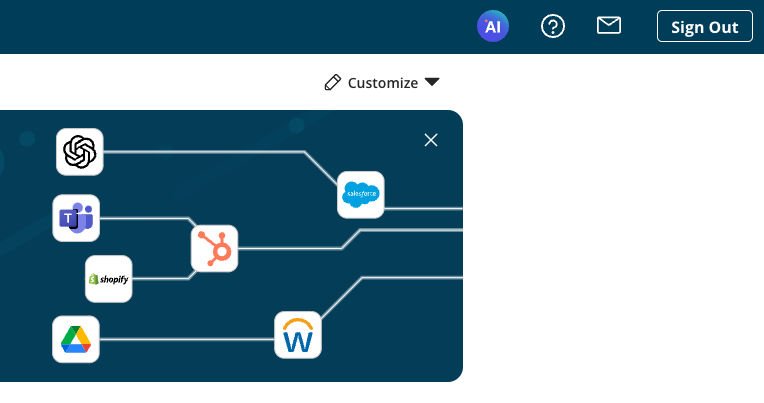Boomi's ‘Conversational AI’ Update is Latest To Boomi’s AI Vision for iPaaS, Integration
Boomi GPT is bringing “conversational AI” to its iPaaS platform to speed integration and automation projects. IDN talks with Boomi’s CTO Matt McLarty about Boomi’s expanding AI suite and compelling future vision for AI-plus-iPaaS.
by Vance McCarthy
Tags: AI, API, Boomi, GPT, integration, iPaaS, LLM,

CTO

"Boomi GPT allows you to have a conversational interaction with our integration platform."
 Integration Powers Digital Transformation for APIs, Apps, Data & Cloud
Integration Powers Digital Transformation for APIs, Apps, Data & CloudDecember 7, 2023
Boomi GPT is bringing “conversational AI” to its iPaaS platform to speed integration and automation projects. IDN talks with Boomi’s CTO Matt McLarty about Boomi’s growing AI suite and vision.
With Boomi GPT, Boomi is doing much more than simply place an English language query front-end onto their iPaaS capability of Boomi connector library, McLarty told IDN.
“We’re utilizing a more conversational chat experience, so Boomi GPT allows you to have a conversational interaction with our integration platform. This means, in addition to helping quickly solve very specified integration use cases, Boomi GPT lets user tackle “more ambiguous” use cases McLarty said, where users know what they want to accomplish – but aren’t aware of all the technical details. So, you could even ask [Boomi GPT] ‘Hey, connect my CRM to my ERP.’
Even with such a wide-open prompt, under the covers the Boomi iPaaS will already know much of the data it needs (or how to find it autonomously). That said, it may also start a two-way conversation with users to get more details on the project.
Boomi GPT is designed to provide an efficient ‘co-pilot” for many integration-related tasks, McLarty noted. That’s because once the integration is delivered, users can accept or modify the output. In addition to integrations, users can also ask Boomi GPT to build integrations, APIs and even master data models.

To use Boomi GPT, users simply click the AI icon, enter a prompt in the chat window and click Send. This starts your Boomi GPT conversation. Click New Conversation and you clear the prior conversation and start a new one.
Boomi AI, and Boomi’s Vision for AI-Enriched iPaaS
Boomi GPT is the latest in an array of Boomi AI suite of capabilities revealed this year. Other notable Boomi AI capabilities include:
Designing Connections: Boomi AI can design integration processes, application programming interfaces (APIs), and master data models by giving Boomi AI a simple English-language command such as “Connect my CRM and invoice systems.”
Optimizing Operations: Boomi AI provides actionable intelligent insights, which let users do predictive maintenance, automate updates and even solve problems proactively. Again, a simple command is all that’s required: “A data attribute in Salesforce has changed. Would you like to apply it across your systems?” make previously menial tasks quick and easy.”
Orchestrating experiences. Boomi AI also knows about a system’s topology, so Boomi will know how to orchestrate processes across applications to meet the needs of specific users or departments.
“We are taking our intelligent integration and automation platform to the next level by making it AI-first – enabling AI to responsibly build and complete integrations and transform automation for our customers.” said Ed Macosky, Chief Product Officer at Boomi in a statement.
Boomi’s investments to AI-enrich their integration capabilities will address many of today’s growing business and IT challenges, McLarty told IDN. These include data fragmentation, siloed systems, lack of data governance, growing need for security and inability to hire skilled staff.
“Think about what Boomi's heritage is. It’s around integration, automation, APIs, data integration and data governance – even master data management. We think AI can prove extremely relevant, even revolutionary, to all these capabilities.”
And Boomi is taking its vision for AI beyond its core iPaaS platform, McLarty add, working with partners to forge an integration-centric AI ecosystem.
“I have a team who's building stuff right now on the Boomi platform to plug into all the exciting vector databases and large language model technologies coming. This [‘ecosystem” or partner approach] will help us come up with some very useful results – so it’s fun times,” he said.
As an even broader vison, Boomi AI is further setting the stage for a new generation of integrated enterprise, or “enterprise composability,” McLarty shared with IDN.
“[Composability] is very much a part of the Boomi vision now, helping enterprises desal with ‘digital fragmentation’ from disconnection among apps, data, flows and even business imperatives,” McLarty said. Boomi sees that when AI is infused with an iPaaS-based approach, it can bring “digital cohesion” and improving interconnected-ness among apps, data and flows.
He shared one example of this fusion between Boomi iPaaS and Boomi AI.
Boomi offers “recipes” to support Retrieval-Augmented Generation (RAG), utilizing a vector database and large language models. [RAG is an AI framework for retrieving facts from an external knowledge base and can add business-specific context to a user's LLM request. ]
In fact, Boomi is also working with a lot of other professionals from the data engineering space. “That’s very exciting, and we’ll start to re-invent some well-known concepts,” in a way that fits the AI era, McLarty added.
AI+ iPaaS Will Drive Re-fashioned Enterprise Pipelines
At Boomi, all the possibilities from AI are driving lots of re-thinking about how integration can deliver force multipliers of new value to users. Perhaps there’s no greater example than with how Boomi engineers are re-imagining the concepts of “pipelines.”
“What companies are going to need to really get valued of AI, is not simply a “data pipeline” that puts data into a data warehouse, but more of a “context pipeline on the supply side,” McLarty said. This is where data needs to be contextualized so it will have meaningful interactions with models, prompt and so forth. This is also where RAG really comes in because you’ll need to sort of tune the models in real-time to get results that are personalized for your business.”
Boomi engineers define a Context Pipeline as “the data-level setup of an AI business outcome. This might be fine tuning a model, it might be loading information into a vector database, or it might be any number of "training type activities."
Boomi’s context pipeline design vectorizes and inserts your dataset(s) in a Pinecone vector index.
For real value, the “context pipeline” should be paired with an “action pipeline on the consumption side,” where you need to get the data back into the systems, McLarty said. “You actually need a whole new pipeline coming from the systems of intelligence into the systems of engagement that we think is going to be a fundamental need.” So, in this vision for AI, it’s not just the data engineer or data scientist that is the end user. The end user of your application are your data end users too.
Boomi engineers define the Action Pipeline as ”the human-engagement portion of an AI use case.” This may be surfaced through a chat tool, a website, or perhaps a voice application. The action pipeline will usually include logic, orchestration, and systems surrounding the core LLM call.
With Boomi’s approach, the action pipeline wires an “engagement interface” into the core template, which will semantic search the user's request [with prompts from GPT-4] against the Pinecone dataset. “In this way we are getting the benefit of a large dataset's most relevant information via semantic search, and we are also letting the LLM shine in its strength -- generating a final answer to the user's prompt by leveraging all of that specific business context,” wrote Chris Cappetta, a Boomi solutions architect in a recent technical post.
And, if course these two novel pipelines -- “context pipeline” on the supply side, this “action pipeline” on the consumption side – will need “foundational capabilities” of an iPaaS, McLarty added., including API Management, integration and automation. “So, we have a sort of a reference architecture for how we're how we're seeing this play out.”
To summarize, McLarty is convinced AI-plus-iPaaS, will have an amazing and exciting future together.
“Knowing the integration game like we do. I think part of the value proposition is this: You want to find the balance of doing the simple stuff as simple as possible, doing the commodity stuff as simple as possible. And then on the flip side, being as flexible as possible because there are always unknowns” and new opportunities, he said.
Related:
All rights reserved © 2024 Enterprise Integration News, Inc.


